It’s a household staple, probably sitting in your kitchen drawer right now.
That roll of aluminum foil can go along way if you know how to put it to
work!
Consumer Educator, Teresa Hunsaker, shares innovative ways to use and
re-use aluminum foil.
Aluminum foil is such a staple in most of our homes that we probably take
it for granted. The average American discards about 450 feet of foil every
year. I was raised by parents who reused aluminum foil, and interestingly
enough roughly 70% of Americans recycle or reuse the aluminum they use
too. Simply wash with soap and water, dry, and flatten out with a rolling
pin. Voila!
Here are a number of different ways we could use and reuse your aluminum
foil:
· Sharpen scissors—take a large piece of foil and fold it over several
times (you want about 6 layers of foil) forming a square or rectangle, then
cut the through foil a number of times.
· Scrub grills and pots and pans from burned on messes—crumple some
foil into a wad and use it to clean off your grates on a grill or burned food
in a pan.
· Reflector oven.
· Funnel—curl a piece of foil into a cone shape and open to use as a
quick funnel.
· Prevent static electricity in your dryer—place a large piece of foil
wadded into a ball in your dryer to keep the static electricity down. People
have reported it works like a charm and they have stopped buying dryer
sheets…I personally have yet to try it.
· Keep birds out of trees with strips of foil—cut several 12×2 inch strips
of heavy duty foil and hang up in the branches of your trees—this is
especially nice to keep birds from eating fruit on trees.
· Use as wrapping paper for a gift.
· Polish tarnished silver—line the bottom of a pan (glass Pyrex or
aluminum) with a large piece of foil. Sprinkle with 3-4 TBS of baking soda.
Add boiling water and silver pieces. Let sit for 15 minutes. Rinse and wipe
clean.
· Keep clean shiny silver tarnish free—layer silver with some foil for
storage.
· Preserve steel wool pads—either line soap dish with foil to place your
steel wool pad on, OR, wrap used steel wool pad in foil and place in the
freezer…this keeps them from rusting out so quickly.
· Prevent skin on top of paint—when you have an unused portion of paint
you want to save, and keep from forming a “skin” on the top of, simply cut
some heavy duty foil in a circle the size of the can and place along the top
of the paint before closing down the lid.
· Clean your iron (depending on the surface)—sometimes the bottom of
your iron gets a little build up on it. Simply crumple some foil into a ball
and rub gently with a little water and vinegar. Rinse and dry.
· Soften brown sugar—wrap hard brown sugar in foil and place in oven at
350 degrees for 5 minutes.
· Attach a patch—placing your patch job between two sheets of foil will
provide better heat penetration when applying a repair patch for torn
clothing.
· Keep cold drinks colder and bugs out—after pouring your cold summer
drink, place foil over the top of your drink glass and down the sides, and
punch a straw through the top. This will keep the drink cold longer and the
bugs from flying in.
· Grill a cheese sandwich—while on the road and in hotel rooms, save
money on food by buying sliced cheese and bread. Make your sandwich as
usual, buttering the outside lightly, placing the cheese in the middle,
wrapping your sandwich in foil. Using the iron on medium to high set the
iron on top of the sandwich. After a few minutes turn and brown the other
side. Voila!
· Embossed card embellishment.
· Remove rust from chrome—crumple foil into a ball and rub on rust
spots on chrome—works really well.
· Keep pie crust edges from getting too dark—cut a 2″ strip of foil long
enough to circle the edge of your pie pan. Place foil just along the top
edge of the pie crust about 1″ then smoothing down the remainder under
the pie edge. Bake pie as usual.
· Ironing board reflector— remove the cover of your ironing board and
place a layer of foil over the top of the frame. Replace the board cover and
iron as usual. This will reflect more heat from the iron back up into your
clothing and allow for faster and more effective ironing.
· Wrap the bottom of the ice cream cone to prevent the dripping out the
end.
· Keep pets off furniture—place long pieces of aluminum foil along the
top of cushions and tuck in. When dogs or cats jump up to lay on they will
immediately get off. This will train them to stay off the furniture.
· Keep celery fresh—wrap cleaned and cut celery in foil to store in the
fridge…for some reason this will keep the celery fresher longer.
· Keep paint on a brush fresh—if you need to take a break from painting,
but don’t want to take the time to wash out the brush because you will be
coming back to it, simply wrap the brush tightly with foil. The paint will
not dry (for up to 6-8 hours) and you can resume painting.
I also thought I would check in with the Reynolds Company
(www.reynoldspkg.com) to
get their take on a few Frequently Asked Questions (FAQ’s) to shed some
light on a few more things about aluminum foil for you. Here were my
favorites to share, as I get many questions on these at the USU Extension
office:
Which side of Reynolds Wrap® Aluminum Foil should I use, the shiny or the
dull side?
Actually, it makes no difference which side of the aluminum foil you use—
both sides do the same fine job of cooking, freezing and storing food. The
difference in appearance between dull and shiny is due to the foil
manufacturing process. In the final rolling step, two layers of foil are
passed through the rolling mill at the same time. The side coming in
contact with the mill’s highly polished steel rollers becomes shiny. The
other side, not coming in contact with the heavy rollers, comes out with a
dull or matte finish.
The exception is when using Reynolds Wrap® Release® Non-Stick
Aluminum Foil. The non-stick coating is applied during manufacturing to
the dull side of the foil. Always place the non-stick (dull) side toward the
food.
Which is better for freezing, aluminum foil or plastic?
Aluminum foil has the lowest moisture-vapor transfer rate of all wrapping
materials. This means that it is the most effective in preventing the loss of
moisture and vapor from the food. This is the reason why foil is preferred
over plastic wrap for long-term food storage or freezing.
Can I line the bottom of my oven with aluminum foil?
To avoid possible heat damage to your oven, we do not recommend using
aluminum foil to line the bottom of your oven. Rather, we recommend that
you place a sheet of heavy duty aluminum foil on the oven rack beneath the
pie or casserole you are baking. The foil should be only a few inches larger
than the baking pan to allow for proper heat circulation. The foil will catch
any drips before they reach the oven bottom.
Why does aluminum foil sometimes “melt” and leave black specks on the
food and holes in the foil?
Occasionally when aluminum foil comes in contact with a food that is
highly salted or acidic, small pinholes are formed in the foil. This is a
harmless reaction that does not affect the safety of the food.
If you have any questions, contact Teresa Hunsaker at the Family and
Consumer Science Education Department at the Weber County USU
Extension office at (801) 399-8203 or online at
www.extension.usu.edu/web
er















Add comment